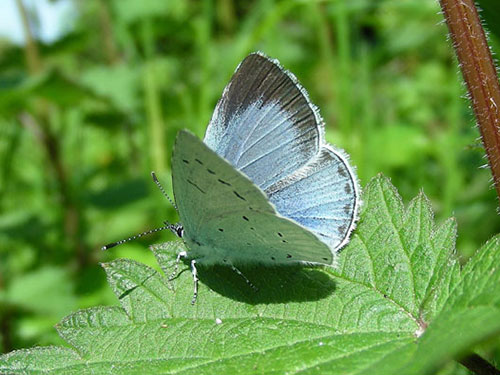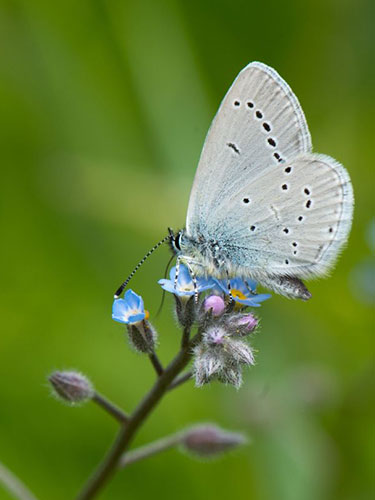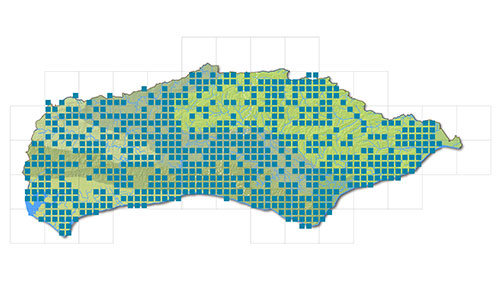


A spring brood female Holly Blue
Photo: Nigel Kemp

Holly blue underside, freckled with delicate black spots
Photo: Nigel Symington

Distribution of Holly Blue records in Sussex between 2010 - 2014
Reproduced from The Butterflies of Sussex by Michael Blencowe and Neil Hulme
There are seven ‘blue’ butterfly species resident in Sussex but during a global viral pandemic the chances of seeing them all are limited. Many of them are tied to specific food plants, specialised habitats and flight times and therefore may be out of reach if you are quarantined in a two-bedroom terraced house in Haywards Heath for six months.
However, there are two ‘blues’ that are within reach of all of us during these challenging times. The Common Blue Polyommatus icarus lives up to its name. It primarily feeds on Common Bird’s-foot-trefoil Lotus corniculatus and subsequently can be found in gardens, meadows and verges where this plant grows. But for many of us struggling through this Covid-19 pandemic an even commoner sighting will be the Holly Blue Celastrina argiolus.
The Holly Blue is a true garden butterfly and the urban areas of Sussex (where most of us find ourselves trapped at the moment) are the perfect habitat for this species. Its here it finds abundant shelter and pockets of warmth amongst our territorial terrain of fences and walls. Importantly its larval foodplants, Holly Ilex aquifolium and Ivy Hedera Helix) are abundant in our residential landscape.
The Holly Blue will have spent the wet winter of 2019/2020 in the pupal stage and will be emerging around about now as part of the year’s first brood (April-June). They will feed, meet and mate and the female will search our towns for suitable egg-laying sites. In the spring they lay eggs mostly on Holly. The caterpillars munch on the flowerbuds, pupate and produce a second brood (July-September) which emerges in the summer. Females from this brood will mainly lay on a different foodplant: Ivy. In some years a small third brood flies in October.
While other blues which are strictly confined to their communities like humans during a pandemic the Holly Blue breaks all the restrictions and roams around our towns like some carefree super-spreader. You’ll most likely see it jittering around in the treetops where you’ll look up and glimpse its silvery grey underwings (unless you’re confined to a 6th storey flat in Hove where you’ll be looking down on the vivid blue of the upperwings). If it settles on a leaf, and you are lucky to get up close, you’ll see these silvery underwings are freckled with delicate black spots.
The butterfly’s population is intimately tied to a parasite - Listrodomus nycthemerus which exclusively parasitises the Holly Blue. This ichneumon wasp uses a slender ovipositor to lay eggs into the Holly Blue’s caterpillar. The wasp’s larvae feed and develop inside the caterpillar and an adult wasp emerges from the butterfly’s chrysalis. The result is a ‘boom and bust’ population cycle for the Holly Blue. The increase in the butterfly’s population is shadowed by that of the wasp until, when the wasp numbers reach their peak, the Holly Blue’s parasitised population is overwhelmed and spectacularly crashes. The wasp then has nothing to parasitise in subsequent years so, after shooting itself in one of its six feet, its population crashes too. This gives any remaining Holly Blues the chance to restock themselves... and the cycle starts again. This is why in some years you’ll see lots of Holly Blues where as in other years they seem rather scarce. Hopefully this current Human / Covid-19 situation isn’t the start of a similar boom/bust cycle. One thing’s for certain, there will be a lot of Holly Blues flying around Sussex in 2020 thinking to themselves “Where is everybody?”.
If you do see Holly Blues (or, for that matter, any other species of butterfly, aphid, moss, dragonfly, beetle, mammal, fungus, collembola, etc.) in your garden this spring, please record your sightings on the iRecord website.
Michael Blencowe
Emeritus professor of butterflyology, University of Small Dole
Every month it is our aim to highlight a species that is “in-season” and, although not necessarily rare or difficult to identify, has been highlighted by our local recording groups as being somewhat under-recorded and for which new records would therefore be welcomed.
If you or your recording group are aware of species such as this then please contact Bob Foreman.